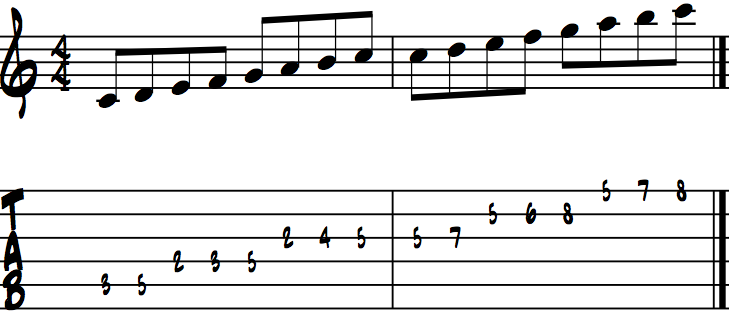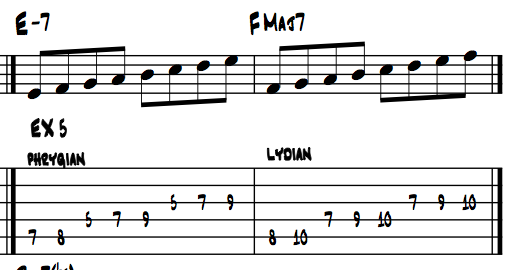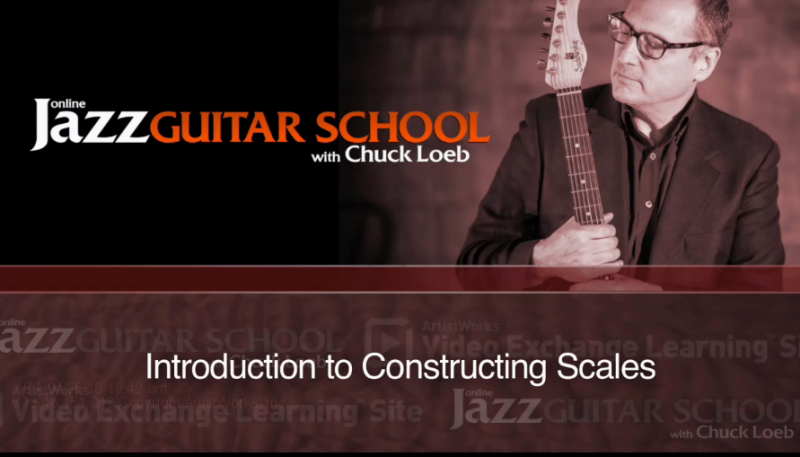Jazz Guitar Scales and Modes: What Does It All Mean?
Aspiring guitarists often hear about the importance of guitar scales for learning how to improvise. In jazz in particular, we so often hear things like "scales go with chords", "we have to practice scales", and "which scale goes with DMaj7#11(add #9)?" – but what does it all mean? To become fluent musicians and improvisers we must develop our understanding of all guitar scales to a high level, but let's first look at some fundamentals.
In the lesson called "Introduction to Constructing Scales" from the Online Jazz Guitar School with Chuck Loeb, we have a very helpful review of how guitar scales fit into the scheme of things. Chuck goes over how to build a major scale, which as he mentions, is paramount because we relate all other guitar scales to the major scale. Ex 1

Let's examine the major scale here in greater depth:

A scale can refer to any set of pitches that are used to define the tonality of a piece of music. Although a great many scales are theoretically possible, over time our western ears have become accustomed to the sounds of three major families of scales above all other less common varieties. These include: Major, Melodic Minor, and Harmonic Minor.
Most of the music that we hear every day is deeply rooted in major scale harmony. This includes most of the popular songs of our time from Gershwin to Katy Perry. Much of the jazz tradition draws on the harmonic implications of the major scale and its modes.
As an exercise, practice the major scale in at least two octaves. Then try playing some patterns that skip a note or two, using different intervals. This builds technique and really drenches your ears in the major scale sound. Ex 2
 \
\
Ex 3

So what is a mode? The term "mode" and "scale" are often confusing because they can be used to refer to the same thing.
It goes back to the the ancient Greeks who had names for various groups of pitches long before equal temperament came along. Over time these words became are formalized referred to as the most common "sounds" we use today. Some of these names may be familiar to you:
- Ionian
- Dorian
- Phrygian
- Lydian
- Mixolydian
- Aeolian
- Locrian
These are the infamous "Greek modes". Today they refer exclusively to the Major Scale. Here's where it gets tricky with these commonly used guitar scales.
As Chuck points out in his online lessons, these modes use the same pitches as the major scale but the sequence changes. Changing the sequence changes the intervals and gives us a different sounding scale, even though the same notes are used.
Look at a piano. Play the white keys starting and ending on C. Now play the white keys starting and ending on D. Congratulations, you just played a Dorian mode. To put this another way, we say that the Dorian mode is a scale that includes all the pitches of the C Major scale, beginning and ending on D. Look at how the sequence changes yet the notes are the same: Ex 4

If we compare the scale spelling, as we talked about in the previous blog and as Chuck describes in the Number System lesson, we can see how the Dorian mode differs from the D Major Scale.
This is an important distinction - The D Dorian mode is relative to the C Major scale. They both include the same pitches. The D Dorian mode is parallel to the D Major scale. They both have a root note of D but the pitch sets differ.
D Major Scale:

D Dorian Mode:

We can clearly see here, using the number system, that the Dorian mode differs from the D major scale in two places, the 3rd and the 7th. Both of these pitches are lowered by a half step in the Dorian scale. This gives us a minor 7th chord tonality and as we recall from the "Introduction to Chords" lesson a min7th chord has a b3 and b7!
As an exercise, play the D major scale and D Dorian mode back to back. Listen to how different they sound.
So now we understand what a D Dorian mode is and how it relates to the C major scale. The final important concept to grasp about the modes is a simple one. D is the second degree of the C major scale (see how important the number system is!) therefore, the Dorian mode always comes from the second degree of a major scale. It’s relative major scale.
This means that the F# Dorian comes from the E major scale. The B Dorian comes from the A major scale.
As an exercise, play the F Dorian, Bb Dorian and A Dorian modes. Which are the relative major scales and which are the parallel major scales? Try writing out the notes of each one.
Now we can return to our list of modes and understand what is going on:
- Ionian: Greek mode name for the major scale itself. C to C
- Dorian: Second mode of the major scale, D to D
- Phrygian: Third mode of the major scale, E to E
- Lydian: Fourth mode of the major scale, F to F
- Mixolydian: Fifth mode of the major scale, G to G
- Aeolian: Sixth mode of the major scale, A to A
- Locrian: Seventh mode of the major scale, B to B


As an exercise, play each of these modes and their corresponding chords slowly. What are the parallel major scales to each one? Remember these are all the relative modes of the C Major scale.
Some of these guitar scales may may sound familiar to you. Others less so. In other lessons in the intermediate section of Chuck’s online guitar lessons you will have a much deeper understanding to how to apply the major scale and all its harmonic richness in your music.

This article was written by Jake Hertzog, learn more at www.jakehertzog.com
- Learning Jazz Guitar Chords with the Number System
- Jazz Guitar with Chuck Loeb: The 6 Positions
- Jazz Guitar: Approach Notes & Neighbor Tones
- Jazz Guitar Lesson on Constructing Arpeggios
- Jazz Guitar Lesson on Ghost Notes
- Guitar Lessons with Martin Taylor: Improvising over Jazz Chords
- Guitar Lessons with Andreas Oberg: Jazz Comping








Comments